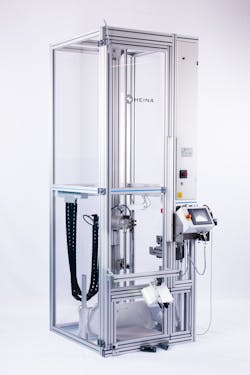Drop Tester Validates Device Durability
Used to test the breakage of various small items and components, Heinä’s Drop Tester enables direct verification of impact results on electronic devices. The item to be tested is attached to suction pads within the machine, then dropped as a selected speed from 3,45 to 6,25 m/s at a height from 600-2000 mm. The Drop Tester can also incorporate a high-speed video camera to verify what actually happens when the tested item hits the platform inside the machine. Compliant with European Machine Directive 2006/42/EY, 2006/95/EY, 2004/108/EY, and standard SFS-EN ISO 12100, the “n” series Drop Tester can create test protocols anywhere and send them through the cloud service to any connected Drop Tester.
This Cloud functionality also enables remote monitoring of test data and all related parameters. Data can be stored in the Cloud, or locally with or without Internet connectivity. An industrial PC is provided with the Drop Tester, to ensure durability and operational lifetime. The Drop Tester Data Report includes product ID, the test protocol used, pass & fails, drop heights, measured velocity, remarks and comments, and the date and time. To get an idea of the ways such a test system can aid electronic product design, we spoke with Ilkka Heinä and Terrell Tronordstr of Konepaja-Heinä about drop testing and its importance in the design process.
EE: Drop testing actually is often overlooked because people focus so much on the electronics performance. You drop the phone, it doesn't survive, all that functionality is gone, right? It appears that a lot of the issues on drop testing focus on the screens, but beyond the screens, what are some of the other issues that could arise with improper drop protection?
Ilkka Heina: It's important that even if users roughly handle their phones, including dropping, they are still able to make calls.
EE: What is the process that you go through to test phones?
Ilkka Heina: Most manufacturers do some kind of impact testing, but there are also a lot of third party test houses, who use our equipment in the tests they provide for the manufacturers. We have standard sizes of equipment, but we are customizing then more and more based on the type of customer. In the past, we only had consumer electronic device manufacturers in our customer base, but nowadays, we see a lot coming from the medical industry. This is because there are a lot of medical device companies making things such as insulin pens and blood-sugar devices, which also need to be tested.
EE: And what are some of the challenges involved in drop test? Is it just simply measuring the after effects? What type of a feedback loop does the manufacturer get from the device that they're using to test the phones?
Ilkka Heina: Every object will start to rotate by its center of gravity once you drop it. Let's say you want to drop a phone from 1.5 meters. With our device, you can set the height and other parameters and repeat the drop, and you can control the orientation, and that's one of the key points. With the latest n series drop tester, we can also create a test protocol in the tester itself, and they are also able to get the report straight from the drop tester database.
EE: Now, when it comes to that data in the database and the information, are there software tools that are provided with the equipment to help the engineers involved understand the information?
Terrell Tronordstr: There's a database functionality, which can run either in the device or it can run in the Cloud. Inside the database, you have more or less two types of things on a high level. You have this test protocol, defined on a very detailed level, how the actual drop testing is done in practice. What are the steps, what are the heights, et cetera. Using predefined test protocols, which are downloaded from the database, sets out what needs to be done. And many of the things are now automated. So earlier, you had to manually inputs all of these parameters into the motion controller, and of course there is room for errors and repeatability and of all of these kind of quality-related aspects. And of course, there's how much time it takes. Now with this new solution, those are all improved.
Once you do those tests, the test results are stored with that database. The user interface for managing this test protocol and test results has access to the database, so you can create new test protocols. Of course, there's different user roles, so if you are a person who can just view reports, then you just see the reports, but then you can also have the privilege to define the best protocol. Using the UI, someone can even remotely define the test protocol, which is then stored to the database and then the motion controller shows the available test protocol in the local user interface. Then the operator can select one of those test protocols, and the tests are executed according to that protocol. Certain things need to be done manually. For example, the operator has to put the device in the right orientation and so forth. Then the test results are stored to the same database.
I think there's also a quality aspect, for example, in how repeatable the tests are. Because if you think about mobile phone development, you have your first set of prototypes, you do the drop tests, and you find some results, you have some issues to fix. Then you do another round of prototypes. Then you've got to repeat the test in the exactly same way, so you have comparable results and you can see the result of the improvements that you've made, whether they had the expected impact.
EE: Ilkka, why don't you give us a nice closing thought so we can tie this up in a nice bow?
Ilkka Heina: What I have learned so far from our customers, is they were quite impressed with our system and service because it really helps their workflow. It also saves time dramatically because they are able to test equipment and get the results and share the test results through the cloud service.
About the Author
Alix Paultre
Editor-at-Large, Electronic Design
An Army veteran, Alix Paultre was a signals intelligence soldier on the East/West German border in the early ‘80s, and eventually wound up helping launch and run a publication on consumer electronics for the US military stationed in Europe. Alix first began in this industry in 1998 at Electronic Products magazine, and since then has worked for a variety of publications in the embedded electronic engineering space. Alix currently lives in Wiesbaden, Germany.
Also check out his YouTube watch-collecting channel, Talking Timepieces.


